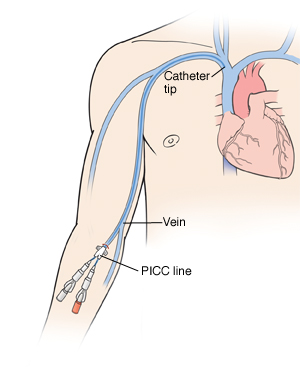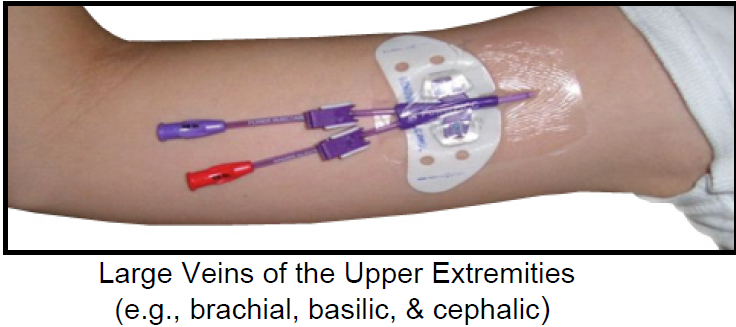Discharge Instructions: Going Home with a Peripherally Inserted Central Catheter (PICC)- Secured with a Stat Lock®
You are going home with a peripherally inserted central catheter (PICC). This small, soft tube has been placed in a vein in your arm. It is often used when treatment requires medications or nutrition for weeks or months. At home, you need to take care of your PICC to keep it working. Because a PICC line has a high infection risk, you must take extra care washing your hands and preventing the spread of germs. 
Patient and Family Caregiver Responsibilities
Look at the PICC exit site every day. Report to your healthcare team if you see:
-
Symptoms of infection - such as increased redness, warmth, new or different drainage or if you have a fever.
-
Symptoms of a blood clot - if you start to have pain or swelling in your neck, shoulder or arm on the side you have the PICC.
-
Signs the PICC has been pulled out - when you see more catheter outside of your arm than before. Do NOT push the catheter back into your arm!
-
Signs of damage - you see a crack, tear or fluid leaking on to your arm.
Routine Care of the PICC
Flushing:
-
Each lumen of your PICC must be flushed every day.
-
If you have a Power PICC Solo, it only needs to be flushed once a week. Your nurse may suggest you flush it more often.
-
Be sure your family caregiver knows how to flush your PICC before you go home.
Dressing, Cap and Stat Lock® Change:
-
The dressing over the PICC exit site needs to be changed at least once a week. It must also be changed if it becomes damp, loose or dirty.
-
The Stat Lock® holding the PICC in place needs to be changed once a week.
-
The caps at the end of the PICC need to be changed once a week.
-
An appointment in the Treatment Center or at your local clinic or doctor’s office needs to be set up for the weekly dressing, Stat Lock® and cap changes. Family caregivers are not usually expected to change the Stat Lock®.
-
Family members are encouraged to learn how to change the PICC dressing and caps, without changing the Stat Lock®, just in case the dressing or caps would need to be changed between appointments.
-
REMEMBER: Never use scissors, pins or any other sharp objects around your catheter!
Showering:
-
Keep the PICC and the dressing dry. You will need to wear the long plastic shower glove while showering. You may also cover your PICC and PICC dressing with Glad® Press and Seal™. Place a large piece over the dressing and press down starting at the middle and smooth it down moving outward.
-
Don’t take tub baths, go swimming, use a hot tub or do other activities that could get the PICC or dressing wet.

Protecting your arm
-
As much as possible, use the arm with the PICC in it for normal daily activities. Lack of movement can lead to blood clots, so it’s important to move your arm as you normally would.
-
Avoid activities or exercises that require major use of your arm, such as sports, unless your healthcare provider says it’s OK.
-
Avoid any activities that cause discomfort in your arm. Talk to your health care team if you have concerns about pain or range of motion.
-
Don’t lift anything heavier than 10 pounds with the affected arm.
Prevent infection with good hand hygiene
A PICC can let germs into your body. This can lead to serious and sometimes deadly infections. To prevent infection, it’s very important that you, your caregivers, and others around you use good hand hygiene. This means washing your hands well with soap and water, and cleaning them with alcohol-based hand gel as directed. Never touch the PICC or dressing without first using one of these methods.
To wash your hands with soap and water:
-
Wet your hands with warm water. (Avoid hot water, which can cause skin irritation when you wash your hands often.)
-
Apply enough soap to cover the entire surface of your hands, including your fingers.
-
Rub your hands together vigorously for at least 20 seconds. Make sure to rub the front and back of each hand up to the wrist, your fingers and fingernails, between the fingers, and each thumb.
-
Rinse your hands with warm water.
-
Dry your hands completely with a new, unused paper towel. Don’t use a cloth towel or other reusable towel. These can harbor germs.
-
Use the paper towel to turn off the faucet, then throw it away. If you’re in a bathroom, also use a paper towel to open the door instead of touching the handle.
When you don’t have access to soap and water: Use alcohol-based hand gel to clean your hands. The gel should have at least 60% alcohol. Follow the instructions on the package. Your healthcare team can answer any questions you have about when to use hand gel, or when it’s better to wash with soap and water.
If your PICC will be cared for at your local clinic or doctor's office, they will want to know:
Home Supplies:
When to seek medical care
Call your provider right away if you have any of the following:
-
Pain or burning in your shoulder, chest, back, arm or leg
-
Fever of 100.4F (38.0C) or higher
-
Chills
-
Signs of infection at the catheter site (pain, redness, drainage, burning, or stinging)
-
Coughing, wheezing or shortness of breath
-
A racing or irregular heartbeat
-
Muscle stiffness or trouble moving
-
Tightness in your arm, above the catheter site
-
Gurgling noises coming from the catheter
-
the catheter falls out, breaks, cracks, leaks or has other damage
© 2000-2025 The StayWell Company, LLC. All rights reserved. This information is not intended as a substitute for professional medical care. Always follow your healthcare professional's instructions.